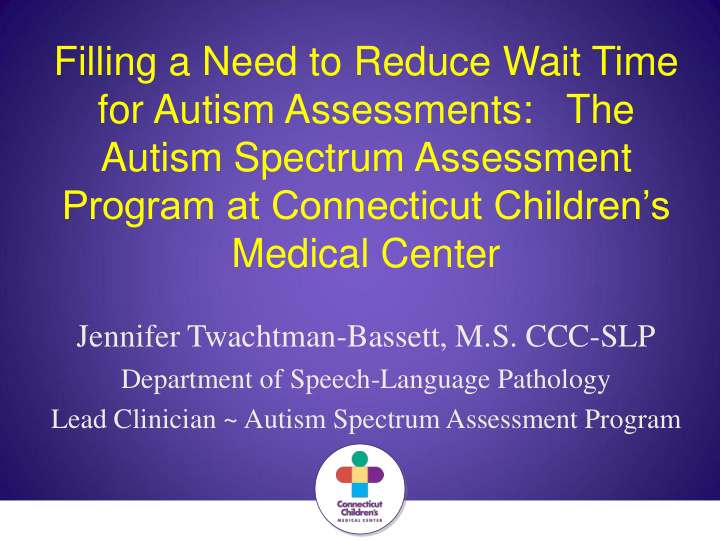



Filling a Need to Reduce Wait Time for Autism Assessments: The Autism Spectrum Assessment Program at Connecticut Children’s Medical Center Jennifer Twachtman-Bassett, M.S. CCC-SLP Department of Speech-Language Pathology Lead Clinician ~ Autism Spectrum Assessment Program
ASAP Goal: Obtain a diagnosis “as soon as possible” in order to jump-start intervention Objective 1: Design a diagnostic program that provides a thorough evaluation for the child and an accurate diagnostic result Objective 2: Ensure a short timeframe from referral to scheduling to appointment to results Objective 3: Provide preliminary parent training and support for next steps
1. Thorough Evaluation & Accurate Result Information from primary care physician: M-CHAT (if between 16 and 30 months of age) Hearing test Lead level (particularly for young or impaired children) Results of other relevant tests (e.g., Fragile X) Information from families/other providers: Parent questionnaire School questionnaire Recent evaluations (children five years of age and over) Obtained before appointment is scheduled, age 6 and up Age 12 months-5 years: Obtained by appointment time
1. Thorough Evaluation & Accurate Result • Extensive training of clinicians involved in ASAP – Symptom presentation, with research updates – Diagnostic tools – Disorders with symptom overlap • Multiple diagnostic tools • Access to medical specialties if needed
Objective 2: Short timeframes • Effective use of clinical resources: – More SLPs than developmental-behavioral pediatricians – Informal analysis has indicated: • High level of diagnostic agreement between SLP and DBP • Specific types of patients that need coordinated appointments: – Children under 2 ½ years of age – Medically complex children (e.g. seizures) – PCP/family seeking to have a diagnosis of ASD removed – History of prematurity <30 weeks – Psychiatric component
Objective 2: Short timeframes • More efficient to have developmental-behavioral pediatrician available when needed • This has allowed us to open up more slots for appointments. • Autism Specialist evaluations are now offered in all of our satellites (average wait 14 days) • This program could be replicated in other locations
Referral & Scheduling Process • Family/Caregiver reports Signs/Symptoms concerns • M-CHAT screening by PCP of ASD • Individual working with observed/reported family reports concerns of ASD • Contact PCP to request referral. • Once script received -> paperwork sent to family • Script is triaged by speech dept. Referral via brief interview • Questionnaires to be completed by family and school. • Once paperwork is received (script, Appointment questionnaires, previous evaluations for children Scheduled ≥5 years)appointment is scheduled
The Team Patient’s families/caregivers Primary care providers Educators and other outside clinicians Autism specialist (Speech-Language Pathologist with specialized training in diagnosis of ASDs) Developmental-behavioral pediatrician
ASAP Process • Review of provided documentation – Parent and school questionnaires – Medical/health reports – Screeners/referral – Developmental/academic reports (testing, service provision) • Confirmatory interviews • Direct assessment • Summary and recommendations
Clinical Diagnostic Tools 1. DSM-IV TR (2000)/DSM-V (2013) – Criteria review/clinical judgment ADOS-2 (2012) – direct assessment instrument 2. Other instruments, as appropriate: – Gilliam Asperger’s Disorder Scale (GADS, 2001) – Childhood Autism Rating Scale, Second Edition (CARS-2, 2009) – Children’s Communication Checklist (CCC, 1998) – Other formal tests for older children • Social Language Development Test (Elementary or Adolescent)
Objective 3: Preliminary Parent Training and Support for Next Steps Results sheet, and, if DBP directly involved, receipt of copy of consult letter sent to referring pediatrician Resource list for ASD Parent training handouts Follow-up appointment for short-term intervention and direct parent training
Results Sheet: Given to Family • Tests administered • Diagnosis (ASD or not) – Brief description of relevant symptoms – Space for consideration of other diagnoses (e.g., apraxia, ADHD) • Recommendations – Speech Therapy (individual or group) – Community-based services (Birth-to-Three, school) – Subspecialty evaluation referrals – Local support organizations – Resources (books, clinical)
Parent Training Handouts • Establishing Intentional Communication • Responding to Joint Attention • Making Social Connections with Your Kids • Using a Visual Schedule System • Expanding Object Play • Symbolic Play • Teaching Kids to Solve Problems • The Art of the Play Date
Younger Child: Follow-Up & Treatment at CCMC • Follow-up scheduled – If diagnosed under two years of age, reevaluation in one year – Reevaluation for diagnostic follow-up either through coordinated ASAP appointment or the speech department only in 6-12 months • Outpatient speech/language therapy – Individual • Family training and support (short-term) • Establishing functional communication • Supporting generalization into the home – Group • Readiness for group established (social language level and behavioral regulation )
Older Child: Follow-up & Treatment at CCMC Follow-up offered as regular DBP continuity care Outpatient speech/language therapy Additional speech and language testing Outpatient social language therapy Individual Social communication (conversation, negotiation, basic needs) Problem solving Comprehension and use of nonverbal signals Parent training Group Readiness for group established (social language level and behavioral regulation) Peer modeling Generalization of skills
Meeting Community Needs • Our triage program has resulted in increased capacity: – Wait time has been reduced from an average of 66 days in FY 2011 to an average of 32 days in FY 2012 (all appointment types combined) – In FY 2013: Increased referral volume due to grant exposure, separated appointment types. Working to reduce wait time for >5 age group and combined MD/SLP appointments (49 days), but wait for Autism Specialist appointments is 14 days.
Thank you! The Connecticut Children’s Team: Sarah Schlegel, MD; Susan Roman, MPH, RN; Ann Milanese, MD Questions? jtwachtman@ccmckids.org
Recommend
More recommend